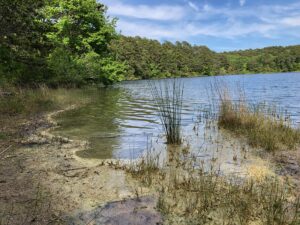WELLFLEET — The beginning of summer brings a few things denizens of the Outer Cape are wary of, bridge traffic and a bump in gas prices among them. But perhaps no early summer event is as vexing for people here as the onset of pine pollen season, when allergies run rampant, and every surface is coated with fine yellow dust.

While grass pollen allergies peak in the summer and weed pollen allergies do so in the fall, trees here shed their allergy-provoking pollen in the late spring, usually peaking around now.
Pollen is a player in flowers’ reproductive cycles. And some trees produce a lot of it because it is not carried to female plants by pollinators like bees. Instead, pine trees release millions of pollen grains into the air on the chance that a handful of them will reach the female reproductive part of another pine.
When the pollen reaches its target, it rehydrates, manufacturing sperm and releasing it into the plant’s ovaries. Essentially, that stuff that clouds the sky, covers your windshield, and makes your sinuses ache is tree semen — or, more accurately, millions and millions of tree testes.
On the Outer Cape, the main trees to reproduce this way are pitch pines, said Stephen M. Smith, plant ecologist at the Cape Cod National Seashore. And since our forests are dominated by pitch pines, we experience a heavy pollen load here, Smith said.
It wasn’t always this way. The Outer Cape came to be covered in pitch pines only because of historical land use practices. When the first colonizers arrived, Smith said, the Cape was a mosaic of heathland and forests with a mixture of pine, oak, and other trees like ash and birch. But the need for firewood and open space for crops led the Europeans to chop down nearly every tree by the end of the 19th century.
“You could stand on parts of the Cape and look at the Atlantic Ocean and Cape Cod Bay at the same time,” said Smith.
Then, as farming faded here, pitch pines took over those formerly open spaces. In the sandy soils of Cape Cod, pitch pines are typically the first tree that grows on cleared land.
The onset of pollen is so sudden and dramatic each year that it can be tempting to think of it each time as an exceptionally bad season. But day-to-day pollen levels, Smith said, have more to do with precipitation than with long-running trends. Windy, dry days, he said, keep pollen airborne and spreading, while rainy days knock the pollen out of the air.
Overall, though, pollen levels appear to be increasing.
Seasonal allergies were first reported around the time of the Industrial Revolution, according to “Under the Microscope: Pollen,” a 2019 article published by the Office for Science and Society at McGill University. “Although we’re not certain why they sprang up then, one theory is that the rapid urbanization and increase in human greenhouse gas emissions triggered their appearance,” wrote Ada McVean.
Elevated levels of carbon dioxide caused by the burning of fossil fuels serve as food for plants, allowing them to produce more pollen than before, according to the Harvard School of Public Health. A warmer climate is also stimulating tree pollen production earlier in the spring and weed pollen later in the fall, stretching out allergy season even more.
There may be a glimmer of hope, Smith said: the arrival of the southern pine beetle. As the Independent has reported, this tree-killing insect was first spotted on Cape Cod about 10 years ago and seems poised to alter the forest composition here by destroying swaths of pitch pines. That may take a while, but Smith said that, as this beetle gains a foothold, it may reduce the volume of our pollen problem.
